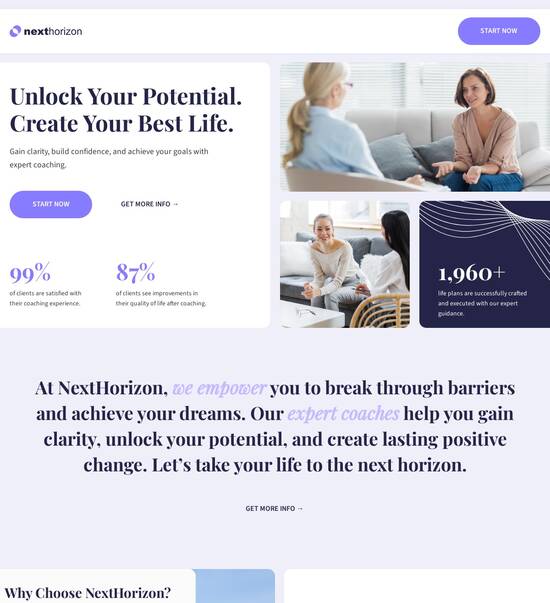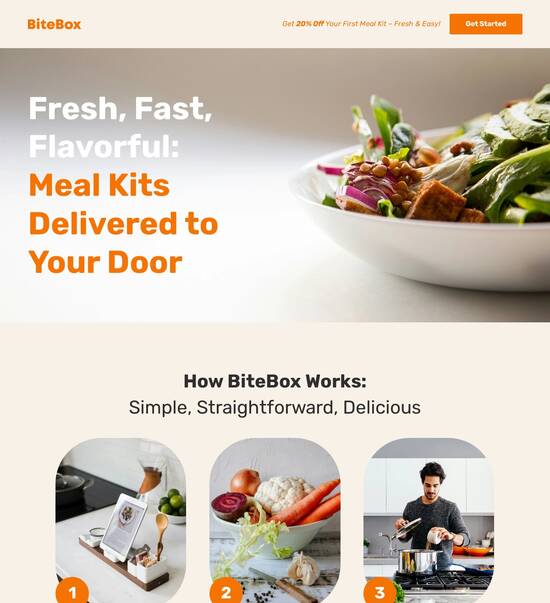
HTML page template with interactive membership registration form
Explore Similar TemplatesAbout template
Use HTML page templates with interactive membership registration form and make your communications easy and transparent. Try our solution today.
Recommended templates

Easy to build without coding
With the intuitive drag-and-drop builder, anyone on your team can create high-converting pages without any knowledge of code or design. Make enhancements to your landing page with custom widgets using Javascript, HTML/CSS, or third-party scripts.

Multiple layouts for any industry and goal
Select from 500+ landing page layouts built to boost conversions across industry-specific scenarios. Customize them by adjusting fonts, adding images, and generating on-brand content with the AI assistant. Quickly scale with Instablocks® and Global Blocks that you can save, reuse, and update globally.

Loads fast and looks polished on any device
Every template is responsive, which means they present professionally on any device and load blazingly fast with our Thor Render Engine. You can also power them up with Google AMP technology to deliver an unparalleled mobile experience and drive higher conversions.

Robust analytics & experimentation
Get real-time updates and reporting across all your devices, showing the number of visitors, conversions, cost-per-visitor, and cost-per-lead. Launch AI-powered experiments, run A/B tests, and use heatmaps to analyze user behavior, then optimize your landing page to maximize conversions.







Easy to build without coding
With the intuitive drag-and-drop builder, anyone on your team can create high-converting pages without any knowledge of code or design. Make enhancements to your landing page with custom widgets using Javascript, HTML/CSS, or third-party scripts.
Multiple layouts for any industry and goal
Select from 500+ landing page layouts built to boost conversions across industry-specific scenarios. Customize them by adjusting fonts, adding images, and generating on-brand content with the AI assistant. Quickly scale with Instablocks® and Global Blocks that you can save, reuse, and update globally.
Loads fast and looks polished on any device
Every template is responsive, which means they present professionally on any device and load blazingly fast with our Thor Render Engine.
Robust analytics & experimentation
Get real-time updates and reporting across all your devices, showing the number of visitors, conversions, cost-per-visitor, and cost-per-lead. Launch AI-powered experiments, run A/B tests, and use heatmaps to analyze user behavior, then optimize your landing page to maximize conversions.
All the features you need to build form for joining a social network html
Explore more featuresLearn how to build html registration form template
Frequently asked questions about free html registration form templates
Leading the way in building high-performing landing pages





Simple html registration form template: Your ultimate how-to guide
In a competitive digital landscape, leveraging high-converting landing pages is crucial for marketers. Instapage offers a powerful platform designed to enhance, optimize, and scale your campaigns, maximizing your ROI. With its user-friendly tools and resources, marketing teams in diverse sectors like business services, tech, education, and finance can effortlessly create compelling landing pages.
Why choose Instapage for landing page creation?
Instapage stands out with its extensive library of over 100 ready-to-use templates tailored for various industries. These templates will not only save you time but are designed to capture leads effectively. Whether you are in marketing and advertising or the educational sector, Instapage has tailored solutions that cater to your unique needs.
- 100+ high-converting templates: Diversely tailored designs streamline the process of capturing visitor attention.
- Intuitive builders: No coding skills needed; create landing pages effortlessly and visually.
- Pre-built lead generation elements: Quickly integrate forms and CTAs to enhance conversion rates.
Efficient landing page optimization
Once your landing page is live, the real work begins. Instapage's built-in experimentation features allow marketers to test and optimize with ease.
- A/B testing capabilities: Create variants to discover what resonates best with your audience.
- Detailed heatmaps: Analyze user behavior to pinpoint areas of improvement.
- Analytics dashboard: Track page performance and make data-driven decisions.
Personalizing your marketing approach
Connecting with your audience is key. Instapage lets you design tailored content that speaks to individual users.
- Dynamic text replacement: Customize messages for different traffic sources to increase relevance.
- AdMaps: Align ads directly with specific landing pages to streamline user journeys.
- Audience metrics tracking: Measure engagement and adjust strategies accordingly.
By leveraging these personalization tools, marketers can expect enhanced engagement and better results from their campaigns.
Ultimately, Instapage transforms the landing page journey, equipping marketers with the tools they need to thrive.
Ready to optimize your landing pages? Explore Instapage today and discover how our platform can elevate your marketing efforts!
People also ask about membership form html code
HTML page template with interactive membership registration form
Understanding the importance of an interactive membership registration form
Membership registration forms are crucial for any online platform aiming to build a loyal customer base. They serve as the primary entry point for users, making it essential to create a form that not only captures necessary information but also encourages users to complete the registration process.
Additionally, a well-designed registration form enhances user engagement and retention. An interactive form can significantly streamline user data collection, which allows businesses to implement targeted marketing strategies driven by user behavior and preferences.
User engagement is enhanced through personalized experiences.
Retention rates improve when users feel valued and understood.
Data collection allows for more focused marketing efforts, increasing conversion rates.
Setting the tone: design and user experience
The design of a registration form plays a significant role in determining completion rates. A clean, intuitive layout with logical navigation instructions can make a positive impact on user experience. Furthermore, responsive design is vital in today’s mobile-centric world, ensuring that users can complete their registration on any device.
Considering design elements such as color, font, and visual hierarchy can guide users toward completing their registration effortlessly. A well-structured onboarding process contributes to overall user satisfaction and brand loyalty.
Features of a comprehensive HTML page template
When discussing an HTML page template for a membership registration form, understanding its features can provide insight into its effectiveness. A well-designed template ensures that key sections necessary for user interaction are both visually appealing and functionally relevant.
Depending on the objective of the website, vital sections to include might encompass introductory texts, user testimonials, and clearly labeled registration fields. This combination helps maintain focus and captures user attention while conveying essential information.
Sections showcasing key features and benefits for users.
Visual components that improve user interaction.
Integrative elements that cater to various user paths.
Technical specifications
Ensuring a responsive design is an essential part of modern web development, particularly for membership registration forms. As more users access websites through mobile devices, templates must adapt to different screen sizes, maintaining usability across various platforms.
Moreover, integrating SEO features into the page template will facilitate higher visibility within search engines, attracting more potential members. Using meta tags, alt texts, and mobile-responsive images can enhance the overall SEO strategy.
Building a robust interactive membership registration form
Creating an effective registration form requires careful consideration of several key elements. Essential fields for capturing user information often include name, email, and password, which provide a solid foundation for user identification.
Incorporating optional fields can enhance user profiling, allowing for personalized experiences down the line. Fields related to interests or preferences can help tailor future communications and offerings, thus increasing the chance of meaningful user interactions.
Name: A basic yet essential field.
Email: Critical for confirmation and communication.
Password: A secure field that protects user data.
Optional fields: Interests or preferences for personalization.
Client-side validation techniques
Implementing client-side validation is a vital task that can significantly improve the accuracy of data entry. Validating user inputs at the browser level prevents errors before forming submissions, facilitating a smoother registration experience.
Additionally, user-friendly error messages can guide users back on track. Providing clear feedback regarding what went wrong during submission can decrease frustration and increase registration completion rates.
The user journey: from landing on the page to becoming a member
Analyzing the registration workflow gives insights into how users interact with the process. A step-by-step breakdown of the signup ensures clarity. Visual cues, such as progress indicators or action buttons, facilitate understanding and help users feel in control of their registration.
Incorporating educational appointments can also streamline this process. For example, allowing users to book an appointment soon after registration fosters commitment to the community. Furthermore, customizing confirmation emails provides a professional touch and opens pathways for future engagement.
Clear step-by-step guidance through the signup process.
Progress indicators to keep users informed.
Opportunity for appointment booking for deeper engagement.
Custom confirmation emails that highlight next steps.
Customizing the registration form template
Effective registration forms must accommodate diverse user needs. Tailoring forms for specific niches—such as education or community engagement—requires understanding the target audience's expectations and motivations.
Utilizing user feedback is invaluable for iterating and enhancing form components. Continuous improvement can lead to increased user satisfaction, as users appreciate forms that genuinely reflect their requirements.
Flexible designs that cater to specific industry needs.
Feedback loops that allow continual improvements.
Customization options that reflect user preferences.
Advanced features and functionality
Integrating social media accounts during registration can facilitate a simpler and quicker signup process. Many users prefer minimizing the steps needed to create accounts, especially on platforms they frequently use.
Additionally, implementing security measures such as capture solutions protects the membership from spam and abuse. By ensuring that only real users register, platforms can maintain quality memberships.
Enhancing engagement with dynamic elements
Incorporating interactive elements into the registration form can grab users’ attention and motivate them to engage more. This might include subtle animations or transitions that make the user experience feel more fluid.
Visual prompts can emphasize critical milestones during the registration process, providing users with a sense of achievement as they progress. This attentiveness to user experience can lead to higher completion rates.
Use of animations or transitions to improve engagement.
Visual cues that guide users effectively.
Creating a sense of progression for completing the form.
Leveraging A/B testing for optimization
A/B testing is an essential methodology for optimizing registration forms. By testing different layouts and content, organizations can gather valuable data on user behavior.
Analyzing these results can lead to data-driven design decisions, ensuring that the form not only achieves a high conversion rate but also meets the needs of its users effectively.
Connecting with upstream systems and services
Backend integration is a critical step for efficient data management when it comes to membership registration forms. Connecting the form with databases or Customer Relationship Management (CRM) systems ensures that user data is collected seamlessly and is available for future marketing efforts.
Respecting privacy regulations while managing user data is paramount. Organizations need to implement security protocols that protect users' information and maintain compliance with various data protection laws.
Efficient data management through backend integration.
Ensuring privacy regulations are met.
Protocols that protect user data against breaches.
Utilizing webhooks and APIs
Webhooks and APIs are increasingly recognized for their ability to automate data transfers to other applications. Establishing a system of real-time updates allows for a responsive membership management experience, enhancing user satisfaction.
With automated updates, users can receive timely notifications about their account status and any changes that may be pertinent to them. This level of interaction fosters a sense of community and engagement.
The benefits of using a registration form template
Using a pre-designed registration form template can greatly enhance the speed at which web design projects are completed. Instead of building forms from scratch, marketers can focus on customizing templates to fit their brand and audience.
Moreover, utilizing templates provides the advantage of minimizing inconsistencies and ensuring best practices in user experience design, resulting in higher completion rates.
Reduced development time allows for faster project delivery.
Focus on customization rather than starting from scratch boosts efficiency.
Ensures best practices in user experience design are followed.
Gaining insights through user data
Another significant advantage lies in the ability to gather valuable insights through user data collected during registration. When equipped with analytic tools, businesses can gain understanding into member needs and behaviors.
This information can inform marketing strategies, guiding efforts toward segments of users more likely to convert and engage. Utilizing data effectively can foster deeper connections between brands and their users.
Final considerations: best practices for integration
As organizations design their registration forms, it’s essential to incorporate accessibility and inclusivity into their approach. Ensuring that forms are usable for all individuals, including those with disabilities, cultivates a welcoming environment for a diverse user base.
Implementing practices such as clear labeling, easy navigation, and alternative text can significantly improve usability. These efforts contribute to an enhanced user experience while positively impacting overall conversion rates.
Accessibility ensures usability for individuals with disabilities.
Clear labeling and easy navigation can improve user interaction.
Inclusion fosters diversity and engagement.
Future-proofing your membership registration process
Staying abreast of design trends and user expectations is crucial for maintaining an effective registration process. As user needs evolve, organizations must be prepared to adapt their forms to align with contemporary user experiences.
Being open to potential new technologies and platforms assures that the registration process remains relevant and competitive, ultimately leading to greater user satisfaction.
Case studies and real-world applications
Examining success stories from different sectors highlights the versatility of interactive registration forms. Educational institutions have effectively implemented interactive registration processes, fostering higher enrollment and engagement from prospective students.
Similarly, nonprofit organizations focusing on community engagement have adapted their registration processes to connect with local members better, creating a nurturing space for collaboration and volunteer opportunities.
Educational institutions see improved enrollment through interactive registration.
Nonprofits engage local communities effectively with tailored forms.
Different sectors utilize forms to connect and involve their audience.
Lessons learned from effective implementations
During the setup and implementation processes, certain challenges may arise. These can include issues like data management concerns or difficulties with integration. Observing these challenges across different organizations can provide valuable insights into what works best.
Feedback from users is crucial in refining registration processes. Listening to user experiences can uncover pain points, leading to improved designs and a better user journey, ultimately contributing to higher conversion rates.
Ready to skyrocket conversions?
Supercharge your ad campaigns with high-performing landing pages
Get started














